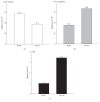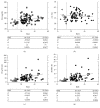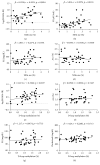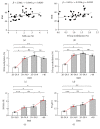Mitochondrial Epigenetic Changes Link to Increased Diabetes Risk and Early-Stage Prediabetes Indicator
- PMID: 27298712
- PMCID: PMC4889851
- DOI: 10.1155/2016/5290638
Mitochondrial Epigenetic Changes Link to Increased Diabetes Risk and Early-Stage Prediabetes Indicator
Abstract
Type 2 diabetes (T2D) is characterized by mitochondrial derangement and oxidative stress. With no known cure for T2D, it is critical to identify mitochondrial biomarkers for early diagnosis of prediabetes and disease prevention. Here we examined 87 participants on the diagnosis power of fasting glucose (FG) and hemoglobin A1c levels and investigated their interactions with mitochondrial DNA methylation. FG and A1c led to discordant diagnostic results irrespective of increased body mass index (BMI), underscoring the need of new biomarkers for prediabetes diagnosis. Mitochondrial DNA methylation levels were not correlated with late-stage (impaired FG or A1c) but significantly with early-stage (impaired insulin sensitivity) events. Quartiles of BMI suggested that mitochondrial DNA methylation increased drastically from Q1 (20 < BMI < 24.9, lean) to Q2 (30 < BMI < 34.9, obese), but marginally from Q2 to Q3 (35 < BMI < 39.9, severely obese) and from Q3 to Q4 (BMI > 40, morbidly obese). A significant change was also observed from Q1 to Q2 in HOMA insulin sensitivity but not in A1c or FG. Thus, mitochondrial epigenetic changes link to increased diabetes risk and the indicator of early-stage prediabetes. Further larger-scale studies to examine the potential of mitochondrial epigenetic marker in prediabetes diagnosis will be of critical importance for T2D prevention.
Figures




Similar articles
-
Longitudinal association between DNA methylation and type 2 diabetes: findings from the KORA F4/FF4 study.Cardiovasc Diabetol. 2025 Jan 18;24(1):19. doi: 10.1186/s12933-024-02558-8. Cardiovasc Diabetol. 2025. PMID: 39827095 Free PMC article.
-
The relationship between BMI and glycated albumin to glycated hemoglobin (GA/A1c) ratio according to glucose tolerance status.PLoS One. 2014 Feb 28;9(2):e89478. doi: 10.1371/journal.pone.0089478. eCollection 2014. PLoS One. 2014. PMID: 24586809 Free PMC article.
-
Uric acid, impaired fasting glucose and impaired glucose tolerance in youth with overweight and obesity.Nutr Metab Cardiovasc Dis. 2021 Feb 8;31(2):675-680. doi: 10.1016/j.numecd.2020.10.007. Epub 2020 Oct 13. Nutr Metab Cardiovasc Dis. 2021. PMID: 33272808
-
Mini-review: Mitochondrial DNA methylation in type 2 diabetes and obesity.Front Endocrinol (Lausanne). 2022 Aug 25;13:968268. doi: 10.3389/fendo.2022.968268. eCollection 2022. Front Endocrinol (Lausanne). 2022. PMID: 36093112 Free PMC article. Review.
-
Mitochondrial Dysfunction, Oxidative Stress, and Inter-Organ Miscommunications in T2D Progression.Int J Mol Sci. 2024 Jan 25;25(3):1504. doi: 10.3390/ijms25031504. Int J Mol Sci. 2024. PMID: 38338783 Free PMC article. Review.
Cited by
-
DNA methylation biomarker selected by an ensemble machine learning approach predicts mortality risk in an HIV-positive veteran population.Epigenetics. 2021 Jun-Jul;16(7):741-753. doi: 10.1080/15592294.2020.1824097. Epub 2020 Oct 22. Epigenetics. 2021. PMID: 33092459 Free PMC article.
-
Cellular Stresses and Stress Responses in the Pathogenesis of Insulin Resistance.Oxid Med Cell Longev. 2018 Jul 9;2018:4321714. doi: 10.1155/2018/4321714. eCollection 2018. Oxid Med Cell Longev. 2018. PMID: 30116482 Free PMC article. Review.
-
Male and Female Rats Have Different Physiological Response to High-Fat High-Sucrose Diet but Similar Myocardial Sensitivity to Ischemia-Reperfusion Injury.Nutrients. 2021 Aug 24;13(9):2914. doi: 10.3390/nu13092914. Nutrients. 2021. PMID: 34578791 Free PMC article.
-
A Pilot Study on the Effects of l-Carnitine and Trimethylamine-N-Oxide on Platelet Mitochondrial DNA Methylation and CVD Biomarkers in Aged Women.Int J Mol Sci. 2020 Feb 5;21(3):1047. doi: 10.3390/ijms21031047. Int J Mol Sci. 2020. PMID: 32033285 Free PMC article. Clinical Trial.
-
Mitoepigenetics and Neurodegenerative Diseases.Front Endocrinol (Lausanne). 2019 Feb 19;10:86. doi: 10.3389/fendo.2019.00086. eCollection 2019. Front Endocrinol (Lausanne). 2019. PMID: 30837953 Free PMC article. Review.
References
MeSH terms
Substances
Grants and funding
LinkOut - more resources
Full Text Sources
Other Literature Sources
Medical

